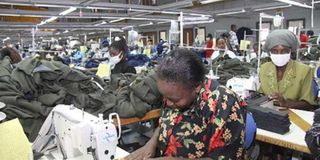New plan to take export zones to all 47 counties

A textile worker in Altex EPZ Textile Manufacturing for foreign markets at Athi River. PHOTO | FILE
What you need to know:
- The country’s 56 EPZs attracted Sh48 billion in collective capital investments in 2015 as tax holidays wooed many to start manufacturing for export.
- The EPZ Authority will soon also have larger units called Special Economic Zones to make it more attractive to investors seeking to carry out high capital ventures.
- Plans are at advanced levels to secure land in Naivasha and set up SEZ along the standard gauge railway.
Kenya is looking to set up at least one Export Processing Zone in all the 47 counties to replicate the economic impacts the initiative has had in the regions they have been situated.
The country’s 56 EPZs attracted Sh48 billion in collective capital investments in 2015 as tax holidays wooed many to start manufacturing for export.
The EPZ Authority will soon also have larger units called Special Economic Zones to make it more attractive to investors seeking to carry out high capital ventures.
SEZs are expected to help double the current manufacturing sector jobs to approximately 1 million, adding between Sh200 billion and Sh300 billion yearly to Kenya’s GDP in the next decade.
Plans are at advanced levels to secure land in Naivasha and set up SEZ along the standard gauge railway.
The current model has received positive uptake, according to EPZA with more than 50,000 Kenyans working in the zones and about 600 non-locals employed. The numbers represent about 17 per cent of the manufacturing sector employment.
Devolved regions
EPZA Chief Executive officer Fanuel Kidenda told Smart Company that the Authority plans to expand to all the 47 counties in a move aimed at spurring economic growth in the devolved regions.
“By June next year, we should be having more than 160 entities because we have approached some county governments are we are set to expand to some more regions,” Mr Kidenda said.
“The EPZ model is the softest landing for those coming to invest in the country because most of the processes are arranged and many other incentives exists.”
The Athi-River zone, which is the EPZA headquarters, has 1,000 acres of land with 44 firms operating in it. Those seeking to establish firms are given land with the EPZ with water, roads and electricity connection in place.
Mombasa has the highest number of zones (22) due to its closeness to the port as most of the goods are exported. Nairobi has eight while Machakos has five.
The Authority says the number of those employed and the overall economic benefits do not necessarily depend on the number of zones or enterprises as indicated in the numbers.
“A place like Athi River here had not much to show but the EPZ has defined the economy of this area as these employees take home at least Sh150 million every month, so you can see that is a significant cash flow in a once sleepy expansive space with little activity,” Mr Kidenda said.
Foreign-owned ventures
Mombasa, which has the second highest number in operating enterprises (23), has generated 21,070 jobs compared to the 44 firms in Nairobi which has created only 14,899 jobs.
EPZ data also show that foreigners own a big percentage of the ventures with 43.8 per cent compared to the 33.7 per cent wholly owned by Kenyans who also have joint venture ownership in 22.55 per cent.
Tax break
The Foreign investors mainly from the USA, United Kingdom, Belgium, Germany Sri Lanka, India, Taiwan, Dubai, Singapore, USA, Seychelles and Mauritius enjoy a raft of tax breaks and exemptions.
They get 10 year corporate income tax holiday and a 25 per cent tax rate for a further 10 years.
They also have a decade of withholding tax holiday on dividends and other remittances to non-resident parties (except for EPZ commercial licence enterprises).



